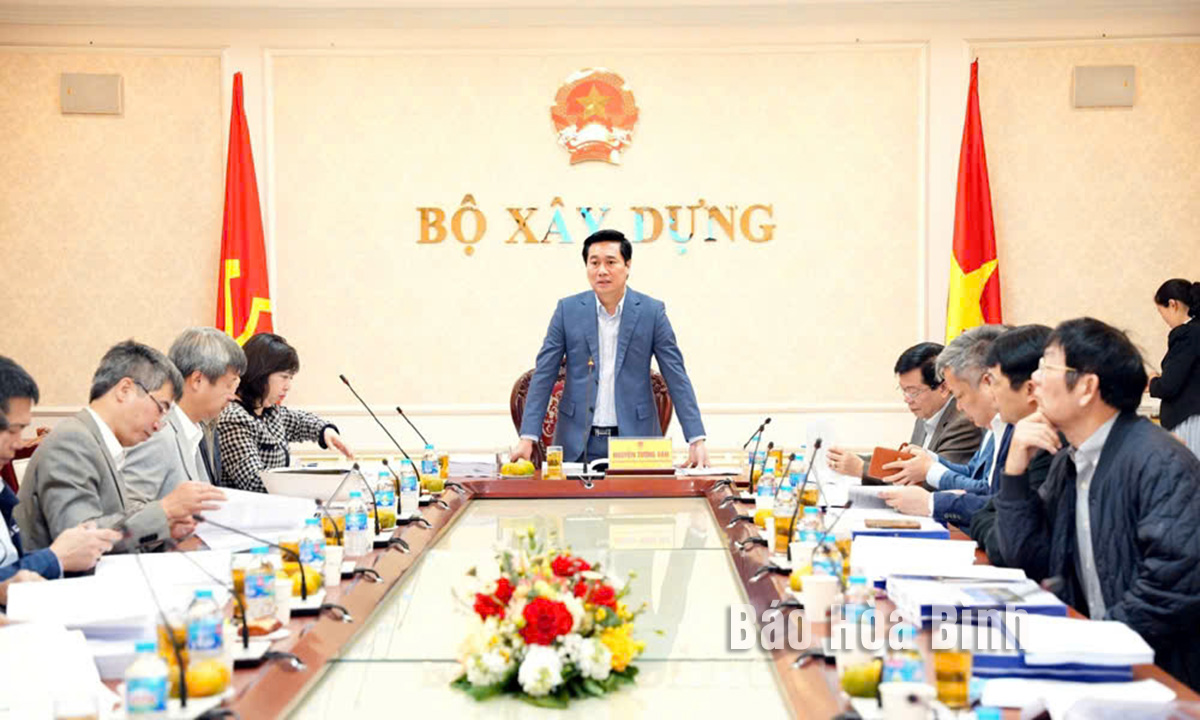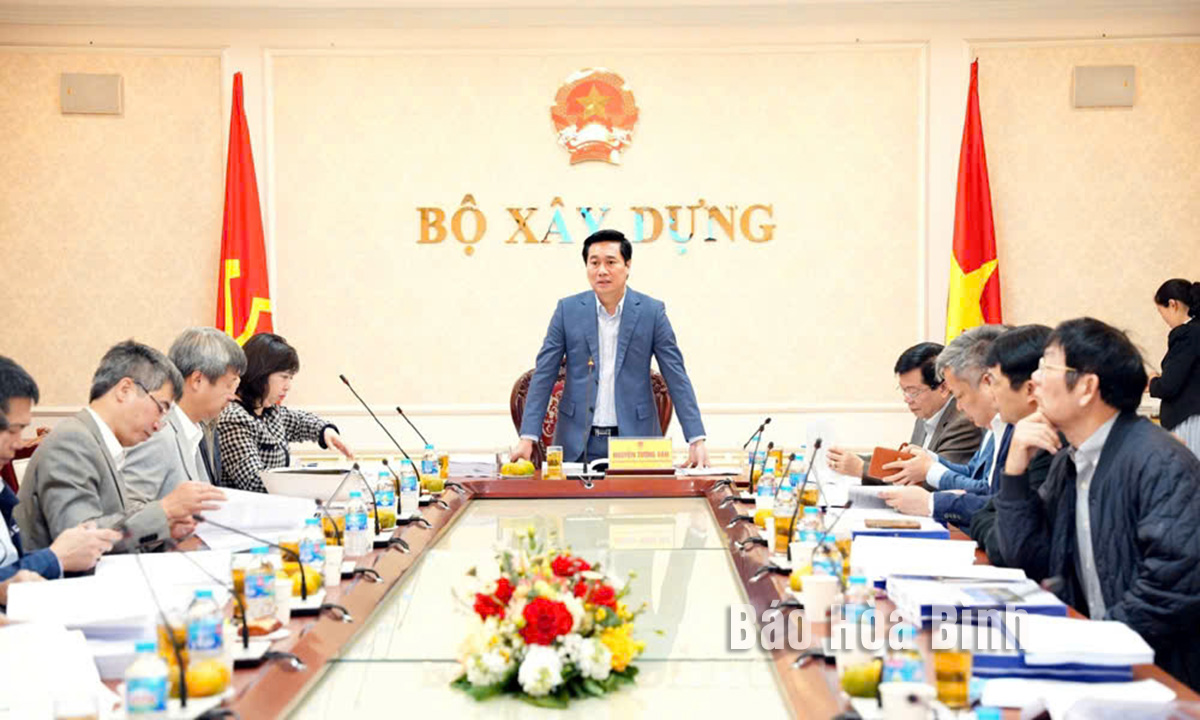
The national evaluation council on February 21 had a meeting to review the master planning for Luong Son urban area, Hoa Binh province until 2045.
Deputy Minister of Construction Nguyen Tuong
Van, Chairman of the council, chaired the meeting.
Local officials including
Nguyen Van Chuong, Vice Chairman of the provincial People's Committee; Nguyen
Duc Dung, Secretary of the Luong Son District Party Committee also attended the
meeting.
The master planning project for Luong Son is
developed in accordance with Resolution 06-NQ/TW dated January 24, 2022, by the
Politburo on the sustainable urban development of Vietnam until 2030, with a
vision towards 2045.
The planning is developed for the entire
administrative boundary area of the district with an area of approximately
36,48 ha, bordering with Hanoi’s Thach That and Quoc Oai districts in the
north; bordering with Kim Boi and Lac Thuy districts in the south; bordering
with Hanoi’s Chuong My and My Duc districts in the east; and bordering with Hoa
Binh city to the west.
Luong Son is located at the western gateway of
Hanoi, connecting to the Northwest region. It strives to become a Class-3 urban
area by 2030. It is an important hub for transportation, logistics, trade,
services, and tourism in the Northwest region. Luong Son is also one of the
socio-economic centers of the eastern area of Hoa Binh province, with main
development drivers being industry, services, tourism - resort, urban development,
and high-tech agriculture, which have strong potential to influence and promote
the development of other regions in the province.
Luong Son aims to become a green, smart,
ecological, and sustainable urban area, supporting functions in education,
health, trade, services, tourism, culture, sports, and housing not only for Hoa
Binh province but also for the western region of Hanoi. This urban area has a
strategically important position in terms of national defence and security.
Regarding the urban development model and
structure, Luong Son develops according to a multi-polar linked urban model
with three centres, five corridors, and four functional areas. Its central pole
is at Luong Son town and adjacent areas along with two poles in the central and
southern parts with their own distinct characteristics; the urban development
poles are interconnected by major urban axes and linked with external transport
corridors, connecting Hoa Binh province and the Hanoi capital region.
In terms of spatial development orientation,
Luong Son is organised based on the formation of three core centers - Northern,
Central, and Southern urban areas. The plan includes five corridors with three
multi-purposed development corridors connecting to the CT.02 expressway, National
Highway 21, and CT.39 expressway, along with two corridors serving trade
services and residential areas along National Highway 6 and the bypass of
National Highway 6. At the same time, under the planning, the Luong Son urban
area is divided into four main functional areas - central urban area, tourism
area, agricultural area, and industrial area for building material production.
According to the evaluation council, the master
planning for Luong Son until 2045 has been meticulously developed by the local
government, using systematic scientific research methods, with clear and
coherent content that meets the requirements set forth. The planning project
complies with the legal regulations on urban planning. However, further
improvements are needed.
On behalf of the provincial government, Vice
Chairman of the provincial People's Committee Nguyen Van Chuong acknowledged
the comments from the evaluation council and committed to quickly directing the
addition, revision, and completion of the project.
Concluding the meeting, Deputy Minister Nguyen
Tuong Van requested the provincial People's Committee and the consulting unit
to fully incorporate all feedback from relevant agencies to finalise the
project. The province needs to review the data, update the legal basis
thoroughly, and ensure accuracy in accordance with current regulations.
Additionally, it should supplement and reassess the data on population, labor,
the state of socio-economic infrastructure, and the region's characteristics.
Regarding planning management and projects, it is necessary to assess current
situation, review and classify projects to ensure the feasibility of the
project.
For the urban spatial orientation, it is
essential to clearly demonstrate the connection between urban characteristics
and natural elements, aligning with the goal of achieving Class-3 urban status
by 2030. In land use planning, a review of the urban development land fund is
needed, adhering to current standards and regulations, while clarifying data on
rural and urban land. Urban design should incorporate distinctive spatial
elements that reflect the regional identity. The provincial People's Committee
and the consulting unit are requested to promptly complete the planning for
submission to the Prime Minister for consideration and approval.
Identifying the application of online public services as a key step in administrative procedure reform and e-government building, Kim Boi district has proactively provided services and supported residents and businesses in accessing and utilising full-process online public services promptly and efficiently. The locality aims to lift the rate of end-to-end online public services to over 90%, with all officials and civil servants handling tasks in the digital environment.
Nguyen Anh Tuyet, hailing from a family steeped in the ancient art of herbal medicine, is transforming local medicinal herbs into high-value concentrated extracts, elevating their worth and healing potential.
Nguyen Phi Long, an alternate member of the Party Central Committee, Secretary of the Hoa Binh provincial Party Committee, and head of the steering committee for the province's key projects, chaired a conference on March 25 to discuss measures for implementing the project on constructing the Hoa Lac - Hoa Binh road and upgrading the Xuan Mai - Hoa Binh section of National Highway 6 under the public-private partnership (PPP) model.
Administrative reform has been identified as a key priority in enhancing state governance, improving the business environment, and facilitating services for citizens and enterprises.
The Standing Board of the Hoa Binh provincial Party Committee met on March 18 to review and guide major investment projects aimed at boosting local socio-economic development.
The air is thick with the hum of drills and the clatter of machinery as the Hoa Binh – Moc Chau expressway takes shape amid the rugged terrain. Welding sparks illuminate the faces of workers, and concrete mixers churn relentlessly, laying fresh pavement on the newly-carved road. The construction site buzzes with a palpable sense of urgency, particularly in Hoa Binh province where the expressway's future is being forged.



